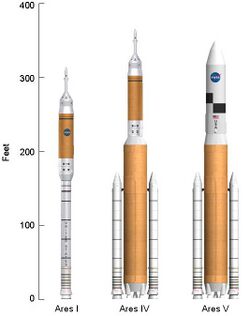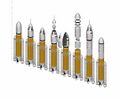Engineering:Shuttle-Derived Launch Vehicle
Shuttle-Derived Launch Vehicle (SDLV), or simply Shuttle-Derived Vehicle (SDV), is a term describing one of an array of concepts that have been developed for building space launch vehicles using the already developed components, technology, and infrastructure of the Space Shuttle program.
In the late 1980s and early 1990s, NASA formally studied a cargo-only vehicle, Shuttle-C, that would have supplemented the crewed Space Shuttle. In 2005, NASA was developing the Ares I and Ares V launch vehicles, based in part on highly modified Shuttle components, to enable exploration of the Moon and Mars.[1][2] The agency also studied a third such vehicle, the Ares IV.
Concepts
SDV concepts are/were proposed even before the Space Shuttle itself began flying.
Shuttle-C
The Shuttle-C was a study by NASA to turn the Space Shuttle launch stack into a dedicated uncrewed cargo launcher. The Space Shuttle external tank and Space Shuttle Solid Rocket Boosters (SRBs) would be combined with a cargo module that take the place of the shuttle orbiter and include the RS-25 engines. Various Shuttle-C concepts were investigated between 1984 and 1995.[3]
National Launch System
The National Launch System (or New Launch System) was a study authorized in 1991 by President George H. W. Bush to outline alternatives to the Space Shuttle for access to Earth orbit.[4] Shortly thereafter, NASA asked Lockheed Missiles and Space, McDonnell Douglas, and TRW to perform a ten-month study.[5]
A series of launch vehicles was proposed, based around the proposed Space Transportation Main Engine (STME) liquid-fuel rocket engine. The STME was to be a simplified, expendable version of the Space Shuttle main engine (SSME).[6][7] The NLS-1 was the largest of three proposed vehicles and would have used a modified Space Shuttle external tank for its core stage. The tank would have fed liquid oxygen and liquid hydrogen to four STMEs attached to the bottom of the tank. A payload or second stage would have fit atop the core stage, and two detachable Space Shuttle Solid Rocket Boosters would have been mounted on the sides of the core stage as on the Shuttle.[6] Period illustrations suggest that much larger rockets than NLS-1 were contemplated, using multiples of the NLS-1 core stage.[8][9]
Constellation program
One of the main goals of Constellation program was the development of spacecraft and booster vehicles to replace the Space Shuttle. NASA had already begun designing two boosters, the Ares I and Ares V, when the program was created. Ares I was designed for the sole purpose of launching mission crews into orbit, while Ares V would have been used to launch other hardware which required a heavier lift capacity than the Ares I booster provided.[10]
Ares I
Ares I was the crew launch vehicle that was being developed by NASA as part of the Constellation program.[11] The name "Ares" refers to the Greek deity Ares, who is identified with the Roman god Mars.[12] Ares I was originally known as the "Crew Launch Vehicle" (CLV).[13]
NASA planned to use Ares I to launch Orion, the spacecraft intended for NASA human spaceflight missions after the Space Shuttle was retired in 2011. Ares I was to complement the larger, uncrewed Ares V, which was the cargo launch vehicle for Constellation. NASA selected the Ares designs for their anticipated overall safety, reliability and cost-effectiveness.[14] However, the Constellation program, including Ares I was cancelled by U.S. president Barack Obama in October 2010 with the passage of his 2010 NASA authorization bill.
Ares V
The Ares V (formerly known as the Cargo Launch Vehicle or CaLV) was the planned cargo launch component of the cancelled NASA Constellation program, which was to have replaced the Space Shuttle after its retirement in 2011. Ares V was also planned to carry supplies for a human presence on Mars.[15] Ares V and the smaller Ares I were named after Ares, the Greek god of war.
The Ares V was to launch the Earth Departure Stage and Altair lunar lander for NASA's return to the Moon, which was planned for 2019.[16] It would also have served as the principal launcher for missions beyond the Earth-Moon system, including the program's ultimate goal, a crewed mission to Mars. The uncrewed Ares V would complement the smaller, and human-rated Ares I rocket for the launching of the 4–6 person Orion spacecraft. Both rockets, deemed safer than the then-current Space Shuttle, would have employed technologies developed for the Apollo program, the Shuttle program, and the Delta IV EELV program.[14] However, the Constellation program, including Ares V was cancelled by U.S. president Barack Obama in October 2010 with the passage of his 2010 NASA authorization bill.
Ares IV
The Ares IV concept combines an Ares I upper stage on top of an Ares V.[17] Specifically, the vehicle would consist of the liquid-fueled core stage from the Ares V design, two five-segment solid rocket boosters, and the liquid-fueled upper stage from the Ares I, as described by NASA in January 2007. The Ares IV would be a combined 367 ft (112 m) tall and could be used to reach the Moon. Total payload capacity would be 90,420 lb (41,000 kg) to 240 miles (390 km) for direct trans-lunar injection.[18]
NASA had considered using Ares IV to evaluate high-speed "skip" reentry profiles of the Orion capsule in 2007.[19] NASA had planned flight demonstrations of Ares I and Ares V hardware in "Heavy Lift" configurations beginning in 2013. The "Heavy Lift" test flights were to test the first stage of the Ares V simultaneously with the Ares I upper stage attached on top to save both time and money. The later Heavy Lift test vehicle configurations are similar to the Ares IV vehicle.[20]
Ares V Lite
Ares V Lite was an alternative launch vehicle for NASA's Constellation program suggested by the Augustine Commission. Ares V Lite was a scaled down Ares V.[21][22] It would have used five RS-68 engines and two five-segment SRBs and have had a low Earth orbit payload of approximately 140 tonnes (310,000 lb).[23] If chosen, Ares V Lite would have replaced the Ares V and Ares I launchers. One Ares V Lite version would have been a cargo lifter like Ares V and the second version would have carried astronauts in the Orion spacecraft.[23]
NASA Side-Mount Vehicle
The Shuttle-Derived Heavy Lift Launch Vehicle (HLV) was an alternate super heavy-lift launch vehicle proposal for the NASA Constellation program. It was first presented to the Augustine Commission on 17 June 2009.
Based on the Shuttle-C concept which has been the subject of various studies since the 1980s, the HLV was a SDLV that proposed to replace the winged Orbiter from the Space Shuttle stack with a side-mounted payload carrier. The Space Shuttle external tank (ET) and Space Shuttle Solid Rocket Boosters (SRBs) would have remained the same.
Jupiter
The Jupiter family of super heavy-lift launch vehicles was part of the proposed DIRECT Shuttle-Derived Launch Vehicle architecture. It was intended to be the alternative to the Ares I and Ares V rockets.[citation needed]
Major benefits were projected from re-using as much hardware and facilities from the Space Shuttle program as possible, including cost savings, experience with existing hardware, and preserving the workforce.[citation needed]
Space Launch System
The Space Launch System (SLS) is a US super heavy-lift expendable launch vehicle, which is under development as of August 2019. It is the primary launch vehicle of NASA's deep space exploration plans,[24][25] including the planned crewed lunar flights of the Artemis program and a possible follow-on human mission to Mars.[26][27][28]
Liberty
Liberty was a 2011 launch vehicle concept proposed by Alliant Techsystems (ATK) and Astrium for phase 2 of the NASA Commercial Crew Development (CCDev) program intended to stimulate development of privately operated crew vehicles to low Earth orbit.
Similar to the defunct Ares I project, which consisted of a five segment Space Shuttle Solid Rocket Booster (SRB) and a new cryogenic second stage, Liberty would combine a five-segment SRB with the core stage of the European Ariane 5 as a second stage.[29][30]
Gallery
References
- ↑ "Ares: NASA's New Rockets Get Names". NASA. June 30, 2006. http://www.nasa.gov/mission_pages/exploration/spacecraft/ares_naming.html. Retrieved November 22, 2006.
- ↑ Malik, Tariq (30 June 2006). "NASA Names Rockets for Moon and Mars Missions". Space.com. http://space.com/news/060630_ares_rockets.html. Retrieved 2006-11-22.
- ↑ "Shuttle-C". GlobalSecurity.org. http://www.globalsecurity.org/space/systems/sts-c.htm. Retrieved 2009-01-20.
- ↑ Bush 1991.
- ↑ Flight International 1991, p. 12.
- ↑ 6.0 6.1 Lyons 1992, p. 19.
- ↑ Federation of American Scientists 1996.
- ↑ Lyons 1992, Figure 1.
- ↑ Duffy, Lehner & Pannell 1993, Figure 1.
- ↑ "Exploration Systems Architecture Study – Final Report" (PDF). NASA. November 2005. Archived from the original on October 13, 2006. https://web.archive.org/web/20061013112649/http://www.nasa.gov/pdf/140649main_ESAS_full.pdf. Retrieved July 6, 2009.
- ↑ Boen, Brooke (July 24, 2009). "NASA–Ares Launch Vehicles". NASA. Archived from the original on July 20, 2009. https://web.archive.org/web/20090720032757/http://www.nasa.gov/mission_pages/constellation/ares/index.html. Retrieved August 5, 2009.
- ↑ Ares: NASA's New Rockets (RealMedia). NASA TV. Retrieved August 15, 2009.
- ↑ Dunbar, Brian; Wilson, Jim (November 23, 2007). "Building NASA's New Spacecraft: Constellation Work Assignments". NASA. http://www.nasa.gov/mission_pages/constellation/main/work_assign.html. Retrieved August 15, 2009.
- ↑ 14.0 14.1 "NASA – Ares I Crew Launch Vehicle". NASA. April 29, 2009. Archived from the original on May 4, 2009. https://web.archive.org/web/20090504015905/http://www.nasa.gov/mission_pages/constellation/ares/aresl/index.html. Retrieved May 13, 2009. Cite error: Invalid
<ref>tag; name "SafetyDesign" defined multiple times with different content - ↑ "Ares V: Application to Solar System Scientific Exploratio". JPL Publication 08-3. Jet Propulsion Laboratory. Archived from the original on March 23, 2012. https://web.archive.org/web/20120323160447/http://trs-new.jpl.nasa.gov/dspace/handle/2014/40727. Retrieved September 13, 2011.
- ↑ Handlin, Daniel (October 11, 2006). "NASA sets Orion 13 for Moon Return". NASA SpaceFlight.com. http://www.nasaspaceflight.com/2006/10/nasa-sets-orion-13-for-moon-return/. Retrieved October 19, 2016.
- ↑ Berger, Brian (January 26, 2007). "NASA Studies Early Moon Shot for New Space Capsule". Space.com. http://space.com/news/070126_ares_moon.html. Retrieved February 11, 2008.
- ↑ Rob Coppinger (January 2, 2007). "NASA quietly sets up budget for Ares IV lunar crew launch vehicle with 2017 test flight target". Flight International. http://www.flightglobal.com/articles/2007/01/02/211318/nasa-quietly-sets-up-budget-for-ares-iv-lunar-crew-launch-vehicle-with-2017-test-flight.html.
- ↑ Berger, Brian (January 26, 2007). "NASA Studies Early Moon Shot for New Space Capsule". Space.com. http://space.com/news/070126_ares_moon.html. Retrieved January 26, 2007.
- ↑ Bergin, Chris. "Ambitious Ares test flight plan proposed for HLV demonstrations". Nasaspaceflight.com, May 10, 2010.
- ↑ Coppinger, Rob. "Will Constellation live on?". Flight International, August 11, 2009.
- ↑ Madrigal, Alexis. "Human Spaceflight Ball in Obama’s Court". Wired, October 22, 2009.
- ↑ 23.0 23.1 Augustine Committee 2009, pp. 38, 64–67, 80.
- ↑ Siceloff, Steven (April 12, 2015). "SLS Carries Deep Space Potential". https://www.nasa.gov/exploration/systems/sls/SLSpresentation.html. Retrieved 2 January 2018.
- ↑ "World's Most Powerful Deep Space Rocket Set To Launch In 2018". http://www.iflscience.com/space/worlds-most-powerful-deep-space-rocket-set-launch-2018/. Retrieved 2 January 2018.
- ↑ Chiles, James R.. "Bigger Than Saturn, Bound for Deep Space". http://www.airspacemag.com/space/bigger-saturn-bound-deep-space-180952802/. Retrieved 2 January 2018.
- ↑ "Finally, some details about how NASA actually plans to get to Mars". https://arstechnica.com/science/2017/03/for-the-first-time-nasa-has-begun-detailing-its-deep-space-exploration-plans/. Retrieved 2 January 2018.
- ↑ Gebhardt, Chris (April 6, 2017). "NASA finally sets goals, missions for SLS – eyes multi-step plan to Mars". https://www.nasaspaceflight.com/2017/04/nasa-goals-missions-sls-eyes-multi-step-mars/.
- ↑ Canceled NASA Rocket Could Return as Part of Low-Cost Space Taxi
- ↑ "ATK and Astrium Unveil the Liberty™ Launch Vehicle Initiative". ATK. Archived from the original on 2011-07-17. https://web.archive.org/web/20110717055741/http://atk.mediaroom.com/index.php?s=118&item=1057. Retrieved 2011-04-09.
Further reading
- Jenkins, Dennis R. (2002). Space Shuttle: The History of the National Space Transportation System. Stillwater MN: Voyageur Press. ISBN 0-9633974-5-1. https://archive.org/details/spaceshuttlehist0000jenk.
External links
- Shuttle-Derived Vehicles
- Shuttle-C
- SDV Presentation
- Ares Rocket at Space.com
- The DIRECT Shuttle-derived launch vehicle proposal
- SDV Heavy Lift Launch Vehicles
- SRB-X Launch Vehicle
- CEV vs Apollo
- Ares I-Crew Exploration Vehicle
- HEFT about Heavy Lift Launch Vehicle












